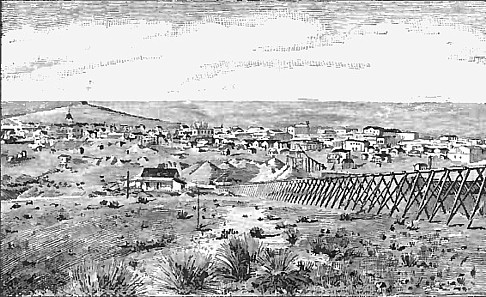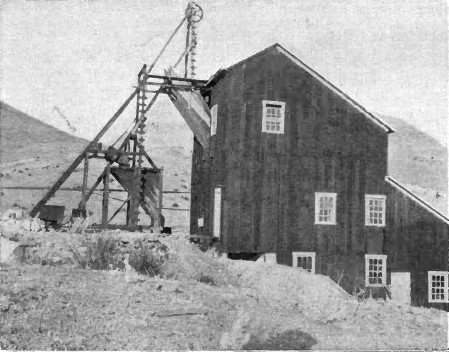The region of the state of Arizona has been claimed first by Spain, and then by Mexico, until it was acquired by the United States. The portion of Arizona lying north of the Gila river, was obtained from the Government of Mexico, under the treaty of Guadalupe Hidalgo, February 2nd, 1848, and the portion lying south of the Gila, was obtained by purchase from the Government of Mexico, under the treaty made by James Gaddsen, on the part of the United States, at Mexico, December 30, 1853. As early as 1540, an expedition was sent by the Viceroy of Spain to examine and take possession of the country, and one of their highest priorities was to search for gold and other valuable minerals. Practically nothing is definitely known of mining operations in Arizona during the Spanish or Mexican period though the Planchas de Plata mine (Plates of Silver) was famous far and wide. The records are barely sufficient to show that a few mines were worked, although that the country was believed to be rich in silver and gold. Early writers subdivide the Planchas de Plata discovery into several lost mines. One mentions an expedition of Dionisio Robles in 1817, into the Santa Rita Mountains, in search of the old mines. Much pure native silver was found in the old prospect holes. Other authors note the evidences of former placer workings near the Quijotoas. In several districts there has been found traces of these early workings; and these, with traditions arising from the Planchas de Plata find show that there can be no doubt that many mines were opened from time to time, and that some were profitably worked during times of peace with the Apaches. It is to this period almost exclusively that we must trace the old workings discovered in later years, and also all the traditions of lost mines that have more than just a purely imaginary foundation.
Below is a collection of 68 true tales of adventure and history from Arizona's early gold mining days:
1. The Arizona Gold Fields: Their
Location And Richness
2. Early Day Exploration for Mines Near Tucson and Tubac
3. The Patagonia or Mowry Silver Mine
4. Placer Gold Mining in Early Arizona
5. Early Mines of Southern Arizona
6. Pauline Weaver: Pioneer Miner and Explorer
7. Arizona Mining Pioneer Herman Ehrenberg
8. Captain Walker’s Expedition Finds Gold on Lynx Creek
9. Pioneer Gold Rush Mining Discoveries in Arizona
10. Henry Wickenburg and the Vulture Gold Mine
11. Precious Metals In the Pioneer Settlement of Arizona
12. How I Became a Hassayamper, Part I
13. How I Became a Hassayamper, Part II
14. Yavapai County, Land of Gold and Mines
15. Arizona Mines and Mining in 1873
16. Arizona Mines and Mining After the Civil War
17. The Famous Silver King Mine
18. Old Time Arizona Copper Mines, Part I
19. Old Time Arizona Copper Mines, Part II
20. Old Time Arizona Copper Mines, Part III
21. Arizona's Lost Gold Mine Stories
22. Minerals Of Pima County
23. The Mining Districts Of Pima County
24. Mines of Santa Cruz County, Part I
25. Mines of Santa Cruz County, Part II
26. Mines of Santa Cruz County, Part III
27. Mines of Santa Cruz County, Part IV
28. Mines of Santa Cruz County, Part V
29. Mines of Santa Cruz County, Part VI
30. The Mineral
Exploration Of Arizona
31. The Silver Mines of Old Tombstone, Part I
32. The Silver Mines of Old Tombstone, Part II
33. Cochise County Mining Districts
34. The Old Gold Rush Town of Prescott
35. The Old Mining Town of Yuma,
Arizona
36. Mines and Mining Resources Of Arizona
37. Mining Districts of Pima and Santa Cruz, Part I
38. Mining Districts of Pima and Santa Cruz, Part II
39. Mining History of Yavapai County, Part I
40. Mining History of Yavapai County, Part II
41. Mining History of Yavapai County, Part III
42. Pinal County Mining Districts
43. Mineral Resources Of Gila County
44. Mines Of Mohave County, Arizona Part I
45. Mines Of Mohave County, Arizona Part II
46. Gold And Silver Mines of Yuma County
47. Mines and Minerals of Maricopa County
48. Mines and Minerals of Graham And Apache Counties
49. Arizona’s Ancient Ruins Of Native Civilizations
50. Arizona’s Early Spanish Missions
51. The General Topography of Arizona
52. The Mines and Mining Enterprises of Arizona
53. History and Description of Yavapai County
54. Arizona's Many "Lost Mines"
55. Mining The Investor, Not The Mine
56. The Great Diamond Swindle
57. Pioneer Prospecting In Arizona
58. History Of Arizona Gold And Silver Mining
59. The American Miner Comes To Arizona
60. Rise Of The Copper Queen
61. A Meteor's Awful Crash
62. Pioneer Arizona Mining Operations
63. Carlton Values Arizona's Mineral Wealth
64. Wickenburg And His Vulture Gold Mine
65. Senator Clark's United Verde Copper Mine
66. Mines Of The Arizona Desert Region
67. A History Of Gold Mining In Arizona
68. The Gold Veins and Silver Lodes of Arizona
69. Spanish Silver Mining in Arizona
70. Copper and Other Metals in Arizona
71. Arizona Mining Districts, Part 1
72. Arizona Mining Districts, Part 2
73. Arizona Mining Districts, Part 3
74. Arizona Mining Districts, Part 4
75. Arizona Mining Districts, Part 5
76. Arizona Mining Districts, Part 6
77. Arizona Mining Districts, Part 7
78. Arizona Mining Districts, Part 8
79. Arizona Mining Districts, Part 9
80. Arizona Mining Districts, Part 10
The silver mines of Arizona were discovered and worked more than a hundred years ago, while Mexico, including Arizona, still belonged to Spain. Excavations have been found which appear to have been made at even an earlier date, and have been attributed to the early Spanish or even the Aztecs, and its not improbable that a part of the glittering mass of gold, silver and turquoise which excited the cupidity of Cortez and his followers, was collected in Arizona. Old Mexican traditions locate Arizuma, an Aztec name, signifying a land of silver, in the valley of the Santa Cruz.
A large portion of the state was known to contain gold, silver, copper, lead and iron ores, in greater or less abundance for many years; there is scarcely a mountain or hill within the Territory that does not contain veins of gold, silver, copper and lead. However for many decades lack of water and hostile tribes allowed no opportunity to fully prospect and mine the region. The Territory of Arizona is pre-eminently mineral in the character of its natural resources. In most countries, mining is viewed as an attractive industry, and when Arizona was a new country where the land was open to all, where the prospector's pick might at any blow disclose the rich silver vein, and where so many have found fortunes, all other pursuits are sure to become secondary. The mineral region is not confined to a few localities, as in Colorado, or to a narrow belt of a few miles in extent, like the famous Comstock Lode of Nevada, but on the contrary, it embraces the entire Territory. Nowhere else in the world, has there been found so many veins of silver ore. Every range of mountains and in some sections every ridge and hill discloses these veins. They have been found from the Mexican boundary to a point north of Prescott, a distance of 250 miles, and from the Colorado to the boundary of New Mexico. No limit can be given of their extent, and a catalogue of their locations would be a large volume of more than 100,000 records.
In 1858 gold placers were discovered on the Gila River some twenty miles above the junction with the Colorado, but extending for several miles along the river; and a new town of shanties sprang into existence, under the name of Gila City. Five hundred miners or more were at one time at work here, some of them very successfully; but there was great difficulty in getting water for travel, the richest diggings being several miles from the river, and before 1862 the glory of these placers had departed, and the city was destroyed by the flood. There was no settlement north of the Gila, though prospecting was carried on in different directions. Beginning in the early 1860s, gold placers were found throughout every portion of the state. The scarcity of water in many localities renders the washing of the earth on a large scale impossible, most of the work being done by individual effort, or two persons working together. A small shaft is sunk a few feet in depth to the bed rock, which is scraped, the earth sacked and carried to the nearest spring or stream and there washed. In this rude way considerable gold in the aggregate is taken from the placers every year. They yield from one to two pennyweight per day, but occasionally a very rich spot is found and a much larger amount taken out. There are several sections where water might be introduced by canals, as on the placers of the San Francisco and in the Horseshoe Basin south of the Gila, and in others water might be collected in reservoirs made by damming gulches or small streams, and sufficient obtained to wash the earth in paying quantities. The Santa Rita Mountains contain many gulches and small valleys where gold nuggets are found in paying quantities. Horseshoe Basin, now organized into a district called Gold Mountain, lying in the central part of Pima County, includes many thousand acres of surface diggings. In 1862 placers were discovered near La Paz, a short distance east of the Colorado River, which have been more or less worked ever since. It is estimated that they yielded a million of dollars the first two years. Several of the mining districts around Prescott were first located on account of their placers, and some are still being worked for their gold ore, giving employment to quite a number of men. The Weaver District in the southern part of Yavapai County has a large area of placer diggings, where mining is now carried on.
Surface diggings are also found in the Bradshaw Basin, Tonto Basin, White Tank Mountains, and in many of the ravines and gulches on the northern slope of the Salt River Valley. In Graham County on the San Francisco River is a large scope of country containing rich placers, and recently very rich deposits have been found in Maricopa County, near Seymour. When the extent of territory is considered which the above enumeration indicates, it will be seen that our placers must for a long time to come afford an important resource of gold production. The more permanent resource of gold will undoubtedly be gold quartz. These veins, like the silver veins, have been found in nearly every part of the Territory, the only limit so far being the limit of exploration. A large proportion of the mines of Yavapai, Pima, and Graham counties are worked exclusively for gold, while all the silver veins carry a greater or less percentage of this royal metal. To this day Arizona is still a major metal producing region, especially for copper ore, and prospectors continue to explore and make important finds. To explore the rich mining history of this state, take a look at the many links on this page.


